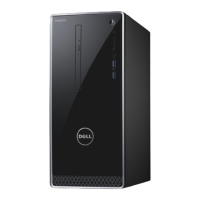Troubleshooting your computer
You can troubleshoot your computer using indicators like diagnostic lights, beep codes, and error messages during the operation
of the computer.
Topics:
• Diagnostics
• Diagnostic error messages
• System error messages
Diagnostics
The computer POST (Power On Self Test) ensures that it meets the basic computer requirements and the hardware is working
appropriately before the boot process begins. If the computer passes the POST, the computer continues to start in a normal
mode. However, if the computer fails the POST, the computer emits a series of LED codes during the start-up. The system LED
is integrated on the Power button.
The following table shows different light patterns and what they indicate.
Table 6. Diagnostics
Number of LED flashes Beep code Problem description
2 amber 2 No memory or RAM detected
4 amber 4 Memory or RAM failure
5 amber 5 CMOS battery failure
3 amber, 4 white 3,4 Recovery image invalid
3 amber, 3 white 3,3 Recovery image not found
Diagnostic error messages
Table 7. Diagnostic error messages
Error messages Description
AUXILIARY DEVICE FAILURE
The touchpad or external mouse may be faulty. For an
external mouse, check the cable connection. Enable the
Pointing Device option in the System Setup program.
BAD COMMAND OR FILE NAME
Ensure that you have spelled the command correctly, put
spaces in the proper place, and used the correct path name.
CACHE DISABLED DUE TO FAILURE
The primary cache internal to the microprocessor has failed.
Contact Dell
CD DRIVE CONTROLLER FAILURE
The optical drive does not respond to commands from the
computer.
DATA ERROR
The hard drive cannot read the data.
DECREASING AVAILABLE MEMORY
One or more memory modules may be faulty or improperly
seated. Reinstall the memory modules or, if necessary, replace
them.
4
36 Troubleshooting your computer

